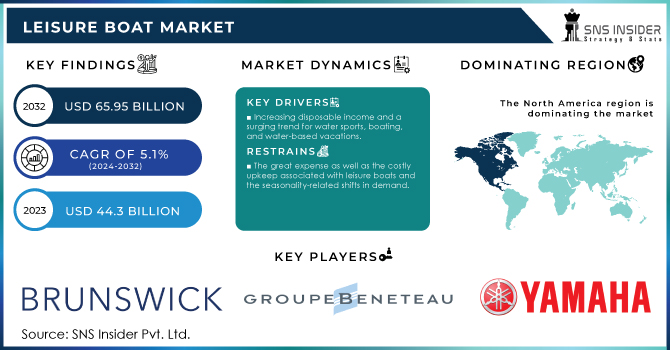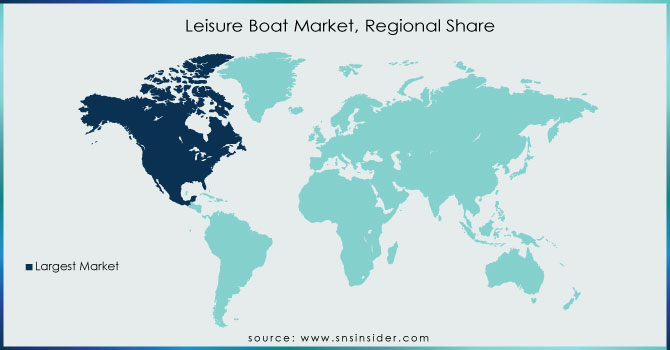Leisure Boat Market Report Scope & Overview:

Get More Information on Leisure Boat Market - Request Sample Report
The Leisure Boat Market size was recorded at USD 44.3 Bn in 2023 and is expected to reach USD 65.95 Bn by 2031 and grow at a CAGR of 5.1% over the forecast period of 2024-2031.
Increasing disposable income among citizens and increasing tourism industries in developing economies like Brazil, and China are a few of the vital factors projecting market growth. In addition, the increasing engagement of the population in recreational and competitive boating activities globally is projected to propel the growth. The evolution of technologies resulting in the launch and penetration of smart boats is expected to burgeon market growth during the forecast period.
Customers increasingly gaining awareness about the advantages of traditional boats having advanced technologies onboard, rising demand for recreational intelligent watercraft, and entry to newer markets remain key growth determinants. Manufacturers have also been adopting high techs like IoT, AI, and smart sensors in the boats to offer users some benefits such as GPS tracking, automatic controls & Smart connect. In addition, integration of these types of technology further helps owners to enhance boat safety and security which indirectly makes them more keen on surfing deep waters.
With numerous boating events & trade shows being organized across the globe, there has been a growing demand for recreational boating activities from tourists. Spending time in the water or on beaches has encouraged a substantial uptick in European and North American tourists (source). Furthermore, the market in China and Australia has opened doors to newer growth avenues due to the growing per capita income of the population residing in these countries. The increasing popularity of recreational boating in Japan, China, and Australia has significantly contributed to the growth of the market. These activities of the various country governments to enhance their marine tourism have propelled the growth of this market. Changes in regulations, the rise of infrastructure, and increased funds to the tourism sector are likely to fuel future chances for growth in the travel market during these years. Furthermore, recreational boating activities spend heavily on outboard boats and yachts among all the boat types across the globe, and that trend boosts the leisure boat market.
Leisure Boat Market Dynamics
Drivers:
- Increasing disposable income and a surging trend for water sports, boating, and water-based vacations.
The leisure market in boats is on an upward trajectory primarily because of the trend in increased disposable income and a greater interest in water-based recreational activities. In some areas, disposable income has reportedly risen to 42%, and therefore, more people have willingness to spend on leisure activities, water sports, boating, and vacations. The trend is apparent among millennials and Gen Z, who spend more on experiential activities rather than material purchases. About 33% of this segment wanted to invest in a water-related holiday and treat it as part of their yearly travel plan. Luxury tourism has given new dimensions to boat rentals and yacht charters as almost 29% of leisure travellers take part in water-related activity as part of the holiday plan.
Notably, popularity for adventure sports contributed to the growth of the market, as wakeboarding, jet skiing, and parasailing activities record high demand with a 25% rise in participation rates over the past five years. Government policies that boost maritime tourism further increase the attractiveness of water sports as in most coastal countries, nearly 18 percent of the tourist budget is spent on marine infrastructure.
Restrains:
- The great expense as well as the costly upkeep associated with leisure boats and the seasonality-related shifts in demand.
The high costs of owning and maintaining a leisure boat are prohibitively cost for many customers, and that impacts adoption levels in the market. Annual expenses on maintenance alone could be 10-15% of the original purchase value of the boat, and that does not help. There is also strong seasonality-related fluctuation in demand. Peak season coincides with favourable weather conditions and holidays; therefore, it peaks in use and demand up to as much as 60-70%. Conversely, it can drop to as low as 40-50% during off-season months. Such a seasonal variation usually has the effect of fragmenting the market, with businesses nearly mainly depending on peak periods to maintain and keep them running throughout the year.
Ownership is rather expensive when mooring and storage fees are taken into account. Costs can reach over 20% of the original purchase price per annum when added with insurance and storage off-season. These costs will make prospective buyers run away, and also encourage current owners to give up when usage is low. Fuel costs have also seen a hike in the industry, pushing the price of running a boat up by 15-20% over the last few years.
Leisure Boat Market Segmentation
By Type
The used leisure Boat segment leads the market and is attributed to gaining over 80% of the market share. This is because the used boat can be delivered fairly soon thus eliminating a longer delivery timeline. A used recreational vessel that has been owned before may have cosmetic blemishes, needs minor repairs, or require upgraded equipment. They are usually cheaper than the newer ones. One of the reasons why most users switch to a used boat is because these boats are intact and stay functional so they also re-sell easily. Also contributing to the high market share of pre-owned vessels is that used boats, generally speaking, are priced less than new boats.
By Product
The motorized new leisure boats are leading the leisure boat market in this segment. All these are pushing the demand for new leisure boats and hence triggering the growth of the new boat market further, with the rising incorporation of advanced technologies such as smart sensors, AI (Artificial Intelligence), and IoT (Internet-of-Things)combined with the availability convenient financing schemes initiated brings in through manufacturers.
Leisure Boat Market Regional Analysis:
The leisure boat sector in North America is on the rise, due to significant contributions from the USA and Canada. Boat ownership is increasing, and incorporates all sorts of boats from luxury yachts, fishing boats, pontoon boats, and personal water transport. North America witnesses the rapid growth of leisure boats. Several factors support the development of the leisure boat market in North America. Firstly, North American high-income levels make it possible for them to indulge in boating as a pastime. Simultaneously, there is a strong preference for outdoor activities that is swelling the popularity of leisure boats. Again, all these pointed to the need for a big leap forward in efficiency and streamlining of technology. Further boosting the demand in North America for leisure boats are exciting water sports like wakeboarding, surfing, and water skiing.
Europe follows the market globally and is anticipated to experience maximum growth in terms of CAGR over the forecast period. Growing pleasure boat application in the UK, France, Germany, Italy, and Spain is projected to fuel regional industry growth. In addition, a rising number of participants in recreational boating activities also bodes well for the incremental opportunity on offer to the market.

Get Customized Report as per your Business Requirement - Request For Customized Report
Key Players in Leisure Boat Market
Some of the major Leisure Boat Market key players are:
-
Brunswick Corporation - Products: Sea Ray Boats, Bayliner, Boston Whaler.
-
Groupe Beneteau - Products: Beneteau Sailing Yachts, Jeanneau Powerboats, Lagoon Catamarans.
-
Yamaha Motor Co., Ltd. - Products: WaveRunner, 242X E-Series Jet Boat, AR195 Sports Boat.
-
Azimut Benetti Group - Products: Azimut Yachts, Atlantis, Benetti Mega Yachts.
-
Marine Products Corporation - Products: Chaparral Boats, Robalo Boats.
-
Sunseeker International Limited - Products: Predator Series, Manhattan Flybridge, Hawk 38.
-
Ferretti Group - Products: Riva Yachts, Pershing Luxury Performance Yachts, Ferretti Custom Line.
-
Malibu Boats, Inc. - Products: Malibu Wakesetter, Axis Wake A24, Response TXi.
-
Princess Yachts Limited - Products: Princess Flybridge, V-Class Sports Yachts, X95 Superfly.
-
MasterCraft Boat Holdings, Inc. - Products: MasterCraft NXT, XT Series, XStar S Wakeboard Boat.
-
HanseYachts AG - Products: Hanse Sailing Yachts, Dehler Performance Yachts, Fjord Motor Yachts.
-
Catalina Yachts - Products: Catalina 355, Catalina 425, Catalina 545.
-
Boston Whaler (owned by Brunswick Corporation) - Products: Montauk Series, Conquest Series, Outrage Series.
-
Bavaria Yachts - Products: Bavaria Cruiser, Bavaria E-Line, Bavaria SR36.
-
Crestliner Boats - Products: Crestliner Super Hawk, Crestliner Commander, Crestliner Fish Hawk.
| Report Attributes | Details |
| Market Size in 2023 | US$ 44.3 Billion |
| Market Size by 2032 | US$ 69.32 Billion |
| CAGR | CAGR of 5.1% From 2024 to 2032 |
| Base Year | 2023 |
| Forecast Period | 2024-2032 |
| Historical Data | 2020-2022 |
| Report Scope & Coverage | Market Size, Segments Analysis, Competitive Landscape, Regional Analysis, DROC & SWOT Analysis, Forecast Outlook |
| Key Segments |
• By Type (New Leisure Boat, Used Leisured Boat), |
| Regional Analysis/Coverage | North America (US, Canada, Mexico), Europe (Eastern Europe [Poland, Romania, Hungary, Turkey, Rest of Eastern Europe] Western Europe] Germany, France, UK, Italy, Spain, Netherlands, Switzerland, Austria, Rest of Western Europe]), Asia Pacific (China, India, Japan, South Korea, Vietnam, Singapore, Australia, Rest of Asia Pacific), Middle East & Africa (Middle East [UAE, Egypt, Saudi Arabia, Qatar, Rest of Middle East], Africa [Nigeria, South Africa, Rest of Africa], Latin America (Brazil, Argentina, Colombia Rest of Latin America) |
| Company Profiles | Avion Marine, Azimut Benetti Group, Baja Marine, Bavaria Yachtbau GmbH, Chaparral Boats, Ferretti, Fountain Powerboats, Bombardier Recreational Products (BRP) Inc., Farr Yacht Design Ltd, Brunswick Corporation |
| Key Drivers | • The rise in overall spending on leisure boats. |
| Market Restraints | • Lack of awareness in the struggling economies. |

